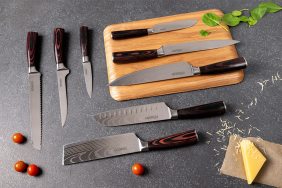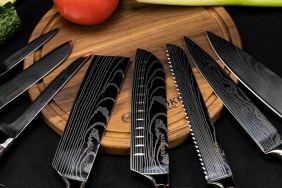When it comes to kitchen basics, there is arguably nothing as important as using the right cutlery. The most expensive pots and pans will never come close to effortlessly being able to dice a tomato (without crushing), core a pineapple, or slice your bread, yet cutlery is often overlooked as people head off to buy the best pots and pans money can buy.
Let’s fix this today. Let’s take a look at all you need to know about cutlery.
When buying knives, it’s important to understand that sets are made for suckers, and you’ll do far better piecing together your own kitchen cutlery. Also, there are dozens of types of kitchen knives out there, but you really only need four. They are:
Types of Kitchen Knives
Chef’s Knife

Photo: Amazon
A good chef’s knife should be 7 to 10 inches and feature a full tang blade. Full tang simple means that the metal part of the blade goes all the way into the handle as opposed to attaching a handle to a piece of steel. This provides increased stability, control and durability when cutting.
Additionally, the knife will either be stamped, or forged. Most chefs prefer stamped, but a newer forged knife can be equally effective. The most important thing to remember here is that price does not equal quality. Expect to spend $50 to $150 on a good chef’s knife that should last a lifetime with proper maintenance.
Arguably, the chef’s knife is the only piece of kitchen cutlery that you truly need, but for the sake of argument, and convenience in the kitchen, let’s detail a couple of others that make life a bit simpler.
Paring Knife

Photo: IKEA
A paring knife is a short (about 2 inches) knife used for small tasks like peeling potatoes or fruit. The only requirement for a good paring knife is that it’s sharp and that it feels comfortable in your hand. You could easily get away under $15 for a paring knife that’s perfectly adequate.
Bread Knife

Photo: Amazon
A bread knife is probably your least-used knife, but it’s important nonetheless. The long, thin, serrated knife allows you to cut through soft, or hard breads with a sawing motion rather than using the chefs knife which would generally succeed only at smashing your beautiful loaf of brioche. Again, an expensive bread knife isn’t necessary, and you can pick up a perfectly acceptable for less than $20.
Fillet Knife

Photo: Amazon
While not necessary, if you find yourself eating a lot of seafood, the chef’s knife probably isn’t doing the job if you want a great fillet. This is another knife where you should plan to fork over a bit of dough. The fillet knife is around 5 to 8 inches with a flexible and surgically sharp blade. These knives are made for filleting fish, so something flexible and sharp is really all you need. Much like the chef’s knife, be sure to select a blade that is full tang, as the bending of the knife will require a handle that remains attached in order to avoid injury.
Types of Knife Material
There are dozens of materials used for knives, but three of the most common are:
- Stainless Steel
- High Carbon Steel
- Ceramic
Stainless are the most prevalent knives due to their strength, ability to keep a fine edge, and their resistance to rust and tarnish (especially when washed in the dishwasher).
High carbon steel is even better than stainless at keeping an edge, but the steel is prone to corrosion when cutting a lot of acidic foods, or if the knife isn’t properly cleaned immediately after each use.
Ceramic knives remain sharp longer than either of the other two, and are a popular choice due to their decreased need for sharpening, as well as a lower price tag. However, these are still made out of ceramic, and they’re somewhat fragile. Breaking one isn’t uncommon.
When buying kitchen knives, the Internet is a valuable resource. Since most stores wouldn’t look too kindly at you bringing your own veggies and cutting board to try them out, user reviews are infinitely more valuable. If the knife is well-reviewed on a highly trusted source, then you usually can’t go wrong with picking it up if it’s in your price range.








